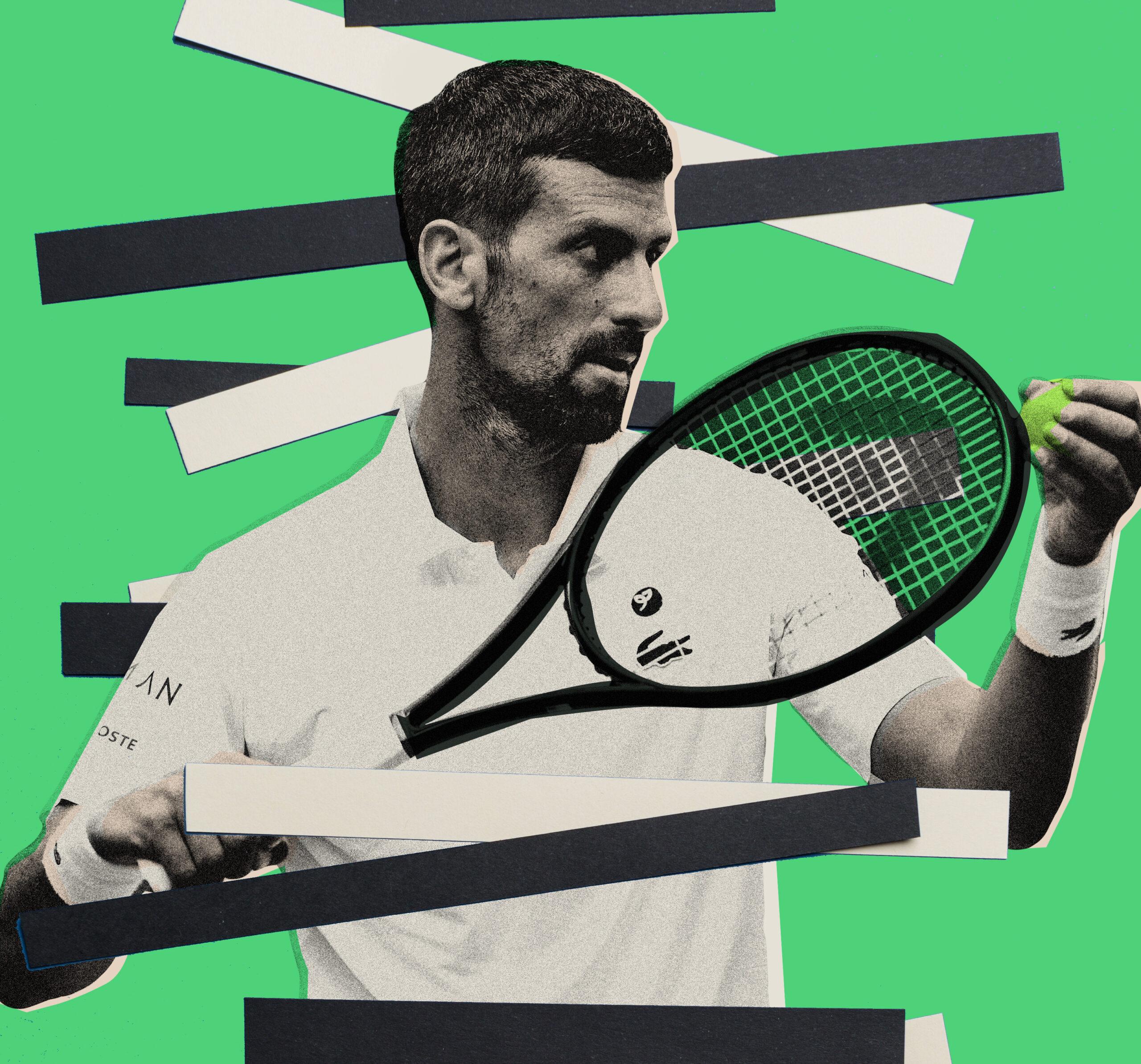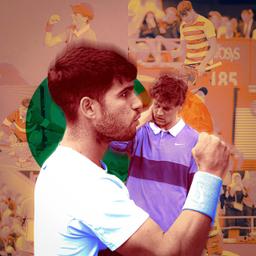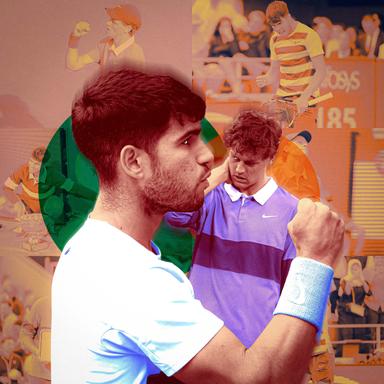
Novak Djokovic has often said that when he was a kid growing up in Serbia, his dream was to win Wimbledon. He’s now done that seven times. Centre Court isn’t where his illustrious career began, but this weekend, that historic patch of grass in southwest London will act as his Alamo—his Battle of Waterloo. He’s heading into his semifinal match against world no. 1 Jannik Sinner as a clear underdog, a position he’s not often found himself in over the past decade. Carlos Alcaraz first took the Wimbledon crown from him in 2023. Now in 2025, Djokovic is trying to reclaim it—perhaps for the last time.
By the time Djokovic first won tennis’s most historic tournament in 2011, he was already a four-time major champion. But he was still chasing the godlike figures of Roger Federer and Rafael Nadal who reigned at Wimbledon. Since then, Djokovic has accomplished everything that a person can achieve in the sport of tennis. He has 24 Grand Slams, more than any man to ever step between the lines. He won Olympic gold for Serbia in Paris last summer, via an all-time serving performance to beat Alcaraz in the gold medal match (that came just weeks after Alcaraz wiped him off the court in the Wimbledon final). He overcame a knee injury that had hampered him at Wimbledon and peaked at exactly the right moment. But he couldn’t sustain that level of play. That Olympic tournament was his only title in 2024. He lost in the third round of the U.S. Open to conclude the major season, and because of his general downturn in form over the past 18 months—as he’s battled injury and inconsistency—his world ranking has dropped to no. 6.
It’s become clear from his performances on the ATP Tour that Djokovic no longer has the ability to contend and dominate all year round, which is understandable: There’s no other player over 35 in the top 40 of the rankings. But he lost this year in the opening round at Indian Wells, Monte Carlo, and Madrid—three of the biggest non–Grand Slam tournaments. He seems to be putting all his energy into the events that matter most: And for Djokovic, nothing matters more than Wimbledon. Federer holds the record for most All England Club titles, with eight. A triumph on Sunday would not only tie Federer’s record but also make 38-year-old Djokovic the oldest Grand Slam champion in men’s tennis history. Federer won his final slam at 36. Nadal did it at 35 (and a little under 12 months).
Djokovic once fought, and successfully escaped, the shadow of Federer and Nadal to carve out his own era of dominance and surpass them in Grand Slam wins. Now, though, he’s staring down new rivals in the form of Alcaraz and Sinner. The two young sensations are dominating the sport right now. Following years of Djokovic serving as the hunted at the top of the standings and holding off an entire generation’s worth of challengers, he’s now once again the hunter, trying to reach the heights of Sinner and Alcaraz, who’ve combined to win the last six slams contested.
First up for Djokovic in that journey back to the top is Sinner, whom he’ll face in a daunting semifinal match on Friday. Djokovic’s chances in that bout are heightened by the emergence of a right elbow injury for Sinner. The world no. 1’s serve and forehand were slightly diminished in his fourth-round “win” against Grigor Dimitrov, which was a win only because Dimitrov tore his pectoral muscle while leading by two sets and couldn’t continue the match. Sinner canceled his outdoor practice on Tuesday and held one indoors, away from the cameras. He then beat Ben Shelton in straight sets on Wednesday to reach the semifinals. Sinner wore a white arm sleeve to protect his right elbow against Shelton and didn’t reach his full top speed on the serve, but his forehand hitting was as clean as he could hope for. Outside of one moment when he seemed to wince in discomfort midway through the second set, you’d never notice he was playing through an injury.
“When you’re in a match with a lot of tension, you try not to think about it,” Sinner said after his win against Shelton. “It has improved a lot from yesterday to today.”
While the grass should be seen as Djokovic’s best chance to beat Sinner, the results of their recent head-to-head matchups will sound alarm bells for the aging champion. Not only has Sinner won 10 of the past 12 sets they’ve played (and all four matches), but also Djokovic—widely considered the best returner in tennis history—has broken Sinner’s serve only once in their past three matchups. That won’t be much easier on the quick grass courts.
Sinner’s playing style has evolved from the best parts of Djokovic’s game. When Djokovic stands across the court from the world no. 1, it’s like he’s staring down a past self in the mirror. Sinner’s pure ball-striking and relentless consistency from the baseline are what have made him nearly impossible for everyone except Alcaraz to beat in the past two years. Plus, Sinner boasts an even taller frame than Djokovic and plays with the increased power of the modern game. On Friday, Djokovic will try to turn every first ball forehand into a potential winning shot. Maybe he’ll even use the backhand slice, which Dimitrov deployed to tremendous success to throw off Sinner’s timing.
If Djokovic manages to pass that test, he’ll likely have an equally difficult challenge awaiting him on Sunday in Alcaraz, the man who has bested him in the past two Wimbledon finals. Djokovic has had considerably more head-to-head success recently against his potential final opponent than against his confirmed semifinal foe. Alcaraz’s movement and defensive skills are borderline insurmountable when he’s at his best, but the young Spaniard can be inconsistent. Djokovic has been able to rush Alcaraz into a lot of errors in their recent meetings.
Djokovic beat Alcaraz in four sets in the Australian Open quarterfinals earlier this year, but a leg injury forced Djokovic to retire mid-match in the next round against Alexander Zverev. In the seven meetings they’ve had since the start of the 2023 season, Djokovic holds the 5-2 advantage head-to-head against Alcaraz. If Djokovic overcomes the battle against Sinner, what will he have left in the tank on Sunday? At Roland Garros, he outlasted Zverev in a marathon quarterfinal, only to be overwhelmed by Sinner in straight sets. Djokovic’s ability to hit the highest level is still there. But now, it comes in flashes.
This is Djokovic’s last real shot at a slam. Sinner has comfortably beaten him in their last two Grand Slam semifinal meetings, at the Australian Open in 2024 and Roland Garros in 2025. But those slower surfaces dull some of Djokovic’s greatest weapons: his serve, his return precision, and his tactical guile. Grass is different. Grass is where he’s reached six finals and won four of the past six Wimbledon tournaments. It’s the surface where the gap between him and the younger stars narrows most. If Djokovic can’t beat Sinner at the All England Club, where else can he beat him? Djokovic is playing his best tennis of the entire year in this tournament, just as he had planned and hoped for.
“If I play like today, I feel like I have a very good chance against anybody, really, on Centre Court of Wimbledon—a place where I maybe feel the most comfortable,” Djokovic said after his third-round win against Dan Evans.
Djokovic is no longer the tireless baseliner who could outlast the game’s best in five-hour slugfests. In his fourth-round win over Alex de Minaur, he lost 69 percent of rallies that extended past nine shots. But he still won the match in four sets thanks to his dominance in the short points, built on his serve and return.
That’s the grass-court equation Djokovic has mastered. The points are shorter here. Offense is rewarded. And at this stage in his career, that suits him far more than it once did.
Across most of his prime, Djokovic’s greatness was built on endurance, defense, and grind. In 2025, it’s about efficiency and how quickly he can win a point. That doesn’t mean Djokovic won’t embrace suffering on the court and get into a war or produce an incredible highlight reel point. But the odds of him winning longer rallies against Sinner and Alcaraz are shrinking with each passing day.
Even with his drop-off in week-to-week performance, it’s clear that Djokovic can still reach a high enough height to contend at majors. But now, he’s not playing just to hang around. By all appearances, it’s title or bust.
“Even though my level of tennis has been going quite up and down and fluctuating much more than it was the case for the most part of my career,” Djokovic said recently, “if you see the last year and a half, I've been kind of volatile with my results. At Grand Slams it stays quite consistent.”
For a generation of tennis fans, Centre Court was Federer’s magisterial canvas. Then it was Djokovic’s fortress. If the Roland Garros final last month taught us anything, it’s that men’s tennis is in excellent hands with “Sincaraz,” and we’ll have incredible battles between them for years to come. But Djokovic is the last remaining link to the best era of men’s tennis history. And he has one more great chance at closure on the court where his dreams all began.



